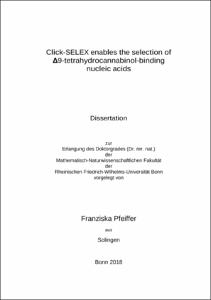Pfeiffer, Franziska: Click-SELEX enables the selection of Δ9-tetrahydrocannabinol-binding nucleic acids. - Bonn, 2019. - Dissertation, Rheinische Friedrich-Wilhelms-Universität Bonn.
Online-Ausgabe in bonndoc: https://nbn-resolving.org/urn:nbn:de:hbz:5n-54344
Online-Ausgabe in bonndoc: https://nbn-resolving.org/urn:nbn:de:hbz:5n-54344
@phdthesis{handle:20.500.11811/7914,
urn: https://nbn-resolving.org/urn:nbn:de:hbz:5n-54344,
author = {{Franziska Pfeiffer}},
title = {Click-SELEX enables the selection of Δ9-tetrahydrocannabinol-binding nucleic acids},
school = {Rheinische Friedrich-Wilhelms-Universität Bonn},
year = 2019,
month = may,
note = {Δ9-Tetrahydrocannabinol (THC) is the main psychoactive compound in the plant Cannabis sativa and the most widely used illegal drug in the world. Its consumption impairs driving skills such as keeping a vehicle on track and has been shown to increase the risk of accidents. Urine tests are available for the detection of THC in a roadside setting, but necessitate facilities and are prone to sample manipulation. In addition, the correlation between impairment and positive tests is poor as a THC-metabolite instead of the active THC is analysed. Oral fluid sampling has emerged as a simple and quick alternative that permits detection of THC itself and therefore evidence for driving under the acute influence of THC. Existing oral fluid tests that are based on antibodies fail to reach the sensitivity and specificity needed for roadside testing.
We aimed to select a THC-binding aptamer for the development of new oral fluid tests for THC. Aptamers are single-stranded nucleic acids that specifically recognise their target molecule with high affinity. Numerous trials with both DNA and 2'F-modified RNA did not succeed in enriching such sequences for THC. Most likely, this is due to the high hydrophobicity of THC and its thereby constrained ability to interact with nucleic acids. Nucleobase-modified aptamers have been shown to dramatically increase the selection success for protein targets. We thus used a recently developed technique, called click-SELEX, that facilitates modification of DNA with an azide of choice. Emulating the interaction of THC with the human cannabinoid receptor 1, benzyl- and trifluoromethylbenzyl-residues were utilised as nucleobase-modifications. This enabled the immediate selection of sequences that bind THC immobilised on epoxy-sepharose. While none of the sequences could be shown to recognise THC in solution, this thesis established the synthesis of fluorescently-labelled THC-derivatives that can be utilised in fluorescence polarisation assays to ascertain affinity constants of future clickmers. In addition, THC-solubility in aqueous buffers with low amounts of organic solvent was thoroughly investigated. Altogether, the findings of this thesis lay the foundation for the selection of THC-binding clickmers that can be implemented in roadside tests in the future.},
url = {https://hdl.handle.net/20.500.11811/7914}
}
urn: https://nbn-resolving.org/urn:nbn:de:hbz:5n-54344,
author = {{Franziska Pfeiffer}},
title = {Click-SELEX enables the selection of Δ9-tetrahydrocannabinol-binding nucleic acids},
school = {Rheinische Friedrich-Wilhelms-Universität Bonn},
year = 2019,
month = may,
note = {Δ9-Tetrahydrocannabinol (THC) is the main psychoactive compound in the plant Cannabis sativa and the most widely used illegal drug in the world. Its consumption impairs driving skills such as keeping a vehicle on track and has been shown to increase the risk of accidents. Urine tests are available for the detection of THC in a roadside setting, but necessitate facilities and are prone to sample manipulation. In addition, the correlation between impairment and positive tests is poor as a THC-metabolite instead of the active THC is analysed. Oral fluid sampling has emerged as a simple and quick alternative that permits detection of THC itself and therefore evidence for driving under the acute influence of THC. Existing oral fluid tests that are based on antibodies fail to reach the sensitivity and specificity needed for roadside testing.
We aimed to select a THC-binding aptamer for the development of new oral fluid tests for THC. Aptamers are single-stranded nucleic acids that specifically recognise their target molecule with high affinity. Numerous trials with both DNA and 2'F-modified RNA did not succeed in enriching such sequences for THC. Most likely, this is due to the high hydrophobicity of THC and its thereby constrained ability to interact with nucleic acids. Nucleobase-modified aptamers have been shown to dramatically increase the selection success for protein targets. We thus used a recently developed technique, called click-SELEX, that facilitates modification of DNA with an azide of choice. Emulating the interaction of THC with the human cannabinoid receptor 1, benzyl- and trifluoromethylbenzyl-residues were utilised as nucleobase-modifications. This enabled the immediate selection of sequences that bind THC immobilised on epoxy-sepharose. While none of the sequences could be shown to recognise THC in solution, this thesis established the synthesis of fluorescently-labelled THC-derivatives that can be utilised in fluorescence polarisation assays to ascertain affinity constants of future clickmers. In addition, THC-solubility in aqueous buffers with low amounts of organic solvent was thoroughly investigated. Altogether, the findings of this thesis lay the foundation for the selection of THC-binding clickmers that can be implemented in roadside tests in the future.},
url = {https://hdl.handle.net/20.500.11811/7914}
}






